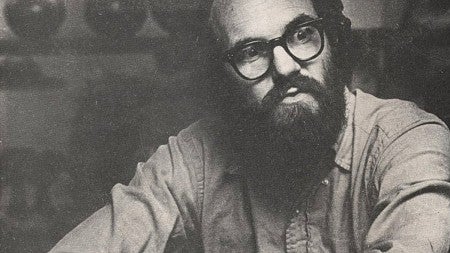
Starting in 1973, Kokis taught at the University of Oregon for more than three decades, and his courses and international workshops—sometimes held along the banks of the Willamette River—were legendary.
Art Professor Brian Gillis described Kokis as a giant in the field of ceramics, leaving an indelible impact on the College of Design and beyond.
“There has never been anyone like him,” Gillis said. “Most people’s influence on a field happens through their work; the ways their work represents a practice or a particular innovation; contributions they may have made to a historical moment; or because of an outsized personality. George worked outside norms and had his greatest impact through the ways the things he made and did blurred lines between roles, and the expectations society has for the spaces that art occupies.”
"Loving art, loving students, loving those on the journey, believing Art Saves Lives” —George Kokis
In Kokis’ Register-Guard obituary, his former UO student Tom Kearcher recalled his time with the professor. “The first time we met in the UO pot shop was August 1973,” Kearcher said. “We ran many miles, mixed a lot of clay, and played darts. What a wonderful and generous teacher George was.”
Kokis grew up in New York City, where he was first exposed to art from a young age. In a 2013 Register-Guard profile about Kokis, he recalls roaming the city streets with friends as a kid and stumbling into the Metropolitan Museum of Art. He identifies that as the day his passion for sculpture was born.

He went on to study at Alfred University, what he called “a mecca for ceramic artists,” and to fire ceramics and instruct at the Brooklyn Museum of Art before taking a job teaching at Ohio University for seven years. On the recommendation of sculptor Hank Murrow, the Kokis family moved to Eugene and George began teaching at the School of Architecture & Allied Arts (now the College of Design), where he stayed until his retirement as an associate professor.
His art helped him work through the effects of Parkinson’s, such as muscle tremors.
“When I do art, the Parkinson’s is not there,” Kokis told the Register-Guard. “I notice the difference right away when I start working.”
In 2013, Kokis showed his work at Clay Space, a Eugene-based art and clay center where he had been a founding supporter since 2007. For the retrospective, Kokis wrote, “Looking ahead, looking within, looking over a life lived—loving art, loving students, loving those on the journey, believing Art Saves Lives.”

At one point, he donated his ceramics collection to the center to help raise funds.
“George Kokis was my first ceramics teacher at Ohio University in 1968. He was a champion for arts education and continuously advocated its importance,” said Jim Laub, one of the Clay Space founders. “A friend and teacher from the beginning of my ceramics journey, I believe the memory of George Kokis will live on through the artistic legacy of his art and the students whose lives were touched through his teaching.”
Gillis said that teaching was a creative practice for Kokis, and he focused on the creation of communal culture from scratch.
“Beginning without language, technology, or materials and growing a culture, together, responsively, in an environment that was nonhierarchical and without the expectations of a discrete, legible work of art,” Gillis explained. “I didn’t know George well, but he has long been a hero of mine, and I am so grateful to have had contact with him and to be a part of his legacy.”
